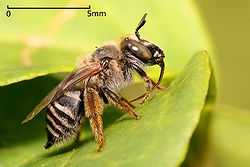Apinae
| Apinae | |
|---|---|
 | |
| Female Tetraloniella sp. | |
| Scientific classification | |
| Kingdom: | Animalia |
| Phylum: | Arthropoda |
| Class: | Insecta |
| Order: | Hymenoptera |
| Family: | Apidae |
| Subfamily: | Apinae Latreille, 1802 |
| Tribes | |
|
Ancylaini | |
The Apinae are the subfamily that includes the majority of bees in the family Apidae. It includes the familiar "corbiculate" (pollen basket) bees — honey bees, stingless bees, orchid bees, and bumblebees. It also includes all but two of the groups (excluding Nomadinae and Xylocopinae) that were previously classified in the family Anthophoridae.
Most species in the subfamily (other than honey bees, bumblebees, and stingless bees) are solitary, though several of the tribes are entirely cleptoparasitic, such as the Ericrocidini, Isepeolini, Melectini, Osirini, Protepeolini, and Rhathymini.
Behaviors
Certain behaviors are known from members of the Apinae that are rarely seen in other bees, including the habit of males forming "sleeping aggregations" on vegetation - several males gathering on a single plant in the evening, grasping a plant with their jaws and resting there through the night (sometimes held in place only by the jaws, with the legs dangling free in space).
Also known from Apinae is the habit of gathering floral oils instead of pollen for use as a larval food; this behavior is otherwise known only from a few lineages in the family Melittidae.
References
External links
- BugGuide.Net: Subfamily Apinae — Honey, Bumble, Long-horned, Orchid, and Digger Bees — images by tribe.
| Wikimedia Commons has media related to Apinae. |